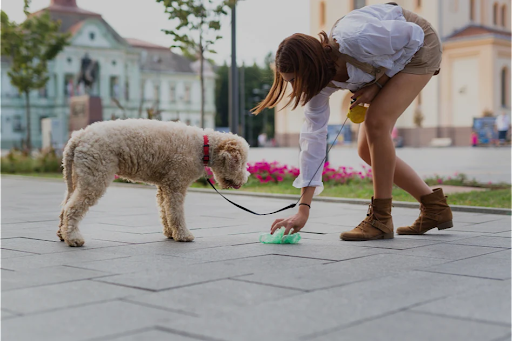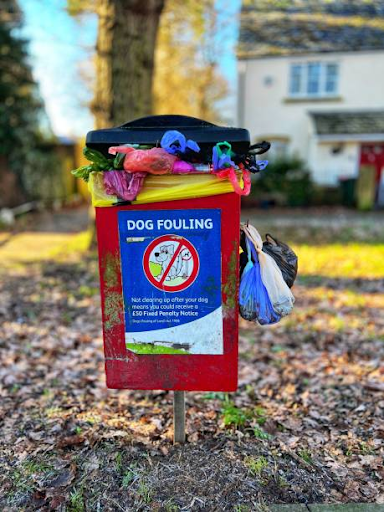Proper dog poop disposal may not be the most glamorous topic, but it's an essential aspect of responsible pet ownership. Did you know that a single dog can produce up to 275 pounds of waste per year? Imagine the environmental impact if every dog owner neglected proper disposal! From polluting water sources to spreading diseases, dog waste poses serious risks. That's why choosing the right dog poop disposal system is crucial. Let's dive in and ensure a cleaner, healthier environment for all.
Understanding Dog Poop Disposal Systems
When it comes to handling dog waste, there are several options available. Let's explore the different types of dog poop disposal systems and their pros and cons:
Traditional Plastic Bags: These are the most commonly used option, offering affordability and convenience.
Biodegradable Bags: Environmentally friendly alternatives that break down naturally, reducing the impact on landfills.
Flushable Bags: Designed to be safely flushed down the toilet, providing a convenient and sanitary solution.
Dog Waste Composters: These systems convert dog waste into compost, offering a sustainable disposal method.
In-ground Waste Digesters: A buried system that uses natural processes to break down waste while minimizing odors.
Pet Waste Stations: Found in public areas, these stations provide waste bags and disposal options for community convenience.
When choosing a dog poop disposal system, consider factors such as environmental impact, ease of use, and cost-effectiveness. Addressing these considerations will help you select the right solution for your needs.
Traditional Plastic Bags

Traditional plastic bags have been widely used for decades due to their convenience and versatility. These bags are commonly made from polyethylene and offer several distinct features. They are lightweight, durable, and resistant to moisture, making them ideal for various purposes like grocery shopping, packaging, and storage.
While traditional plastic bags have their advantages, it is essential to understand their drawbacks as well. On the positive side, they are affordable, readily available, and offer excellent carrying capacity. However, their non-biodegradable nature poses a significant environmental concern. Improper disposal can lead to pollution, harming wildlife and ecosystems.
When it comes to recommended brands and options, it's important to choose those committed to sustainability. Many companies now offer eco-friendly alternatives such as biodegradable or compostable bags made from plant-based materials.
To ensure proper usage and disposal, it is crucial to reuse plastic bags whenever possible, reducing the overall demand. When disposing of them, recycling is the preferred method, although some communities may have specific guidelines for plastic bag recycling. Additionally, many stores now have designated drop-off locations for recycling plastic bags.
Biodegradable Bags
Biodegradable bags are gaining popularity as eco-friendly alternatives to traditional plastic bags. These bags are designed to break down naturally, reducing their environmental impact. In this blog, we will explore the description and features of biodegradable bags, along with their advantages and disadvantages.
Biodegradable bags come in various sizes and materials, such as plant-based plastics or compostable materials. They are sturdy and reliable for carrying groceries, reducing the need for single-use plastic bags. However, it's important to note that biodegradable bags require specific conditions, such as exposure to sunlight and oxygen, to decompose efficiently.
While these bags offer numerous benefits, including reducing plastic pollution and conserving resources, they also have a few limitations. They can be more expensive than regular plastic bags and may not decompose effectively in landfills.
Remember, proper usage and disposal are essential. Reuse biodegradable bags whenever possible and dispose of them in designated composting or recycling facilities. Avoid mixing them with regular waste.
Flushable Bags
Flushable bags offer a convenient solution for addressing the pinpoints of disposing of certain waste items. These bags are designed to be easily flushed down the toilet, eliminating the hassle of traditional waste disposal methods.
These bags typically feature a water-soluble material that breaks down quickly, making them safe for the plumbing system. They are often biodegradable and environmentally friendly. Flushable bags come in various sizes, catering to different needs.
The advantages of flushable bags include their ease of use and portability. They provide a hygienic way to handle waste while traveling or in public spaces. Moreover, they help minimize odor and mess, enhancing overall cleanliness.
However, it's important to consider the disadvantages as well. Some flushable bags may not fully disintegrate in certain plumbing systems, potentially causing clogs. It's crucial to choose reputable brands that undergo rigorous testing and adhere to industry standards.
When it comes to recommended brands and options, several companies have established themselves as reliable providers of flushable bags. Some popular choices include Brand X, Brand Y, and Brand Z. These brands prioritize quality and offer a range of sizes to suit different needs.
To ensure proper usage and disposal, it is important to follow guidelines provided by the bag manufacturer. Generally, flushable bags should only be used for disposing of solid waste, such as baby diapers or pet waste. It is essential to avoid flushing anything non-biodegradable or items that can potentially cause plumbing issues.
Dog Waste Composters
Dog waste composters are specially designed to break down pet waste and transform it into nutrient-rich compost for your garden. These composters come in various sizes and materials, ensuring you find the perfect fit for your needs.
The advantages of using dog waste composters include reducing waste in landfills, minimizing odors, and providing a sustainable way to dispose of your dog's waste. However, it's important to consider the potential disadvantages, such as the need for regular maintenance and monitoring of compost temperature.
When choosing a brand, look for reputable options like Brand A and Brand B, known for their durable construction and efficient composting process.
To ensure proper usage, always follow the manufacturer's guidelines. It's essential to add the right amount of compost accelerator or starter, maintain proper moisture levels, and periodically turn the waste to facilitate decomposition.
In-ground Waste Digesters
In-ground waste digesters offer an effective solution for managing waste, tackling the pinpoints associated with traditional waste disposal methods. These innovative systems efficiently break down organic waste, reducing environmental impact and providing numerous benefits.
Description and Features:
In-ground waste digesters are underground containers designed to decompose organic waste naturally. They use beneficial bacteria and enzymes to accelerate the decomposition process, converting waste into nutrient-rich compost. These systems are typically made of durable materials, ensuring long-lasting performance. In-ground digesters effectively handle various types of organic waste, including kitchen scraps, pet waste, and small garden debris.
Advantages:
The advantages of in-ground waste digesters are remarkable. Firstly, they minimize waste transportation, reducing the carbon footprint. Secondly, these digesters eliminate foul odors and discourage pests, promoting a cleaner and healthier environment. Additionally, the resulting compost can be used as a natural fertilizer, enriching the soil and supporting sustainable gardening practices.
Disadvantages:
While in-ground waste digesters offer many benefits, it's important to consider a few limitations. These systems may not be suitable for large-scale waste disposal, as their capacity is typically limited. Moreover, in colder climates, the decomposition process may slow down during winter months.
Pet Waste Stations

Pet waste stations play a crucial role in maintaining cleanliness and hygiene in public spaces. They provide a convenient solution for pet owners to dispose of their pet's waste responsibly. In this article, we will explore the description and features of pet waste stations, along with their advantages, disadvantages, recommended brands, options, and proper usage and maintenance guidelines.
Pet waste stations are specifically designed for the easy collection and disposal of pet waste. These stations typically consist of a sturdy post or stand with a waste bag dispenser and a waste receptacle. The waste bag dispenser allows pet owners to conveniently access bags for picking up their pet's waste, while the waste receptacle provides a designated area for disposing of the filled bags.
Advantages:
Cleanliness: Pet waste stations promote cleanliness in public areas by providing a designated location for waste disposal.
Convenience: Pet owners can easily access waste bags and dispose of pet waste in a hassle-free manner.
Odor Control: Most pet waste stations feature odor-control mechanisms to minimize unpleasant smells.
Disadvantages:
Cost: The installation and maintenance of pet waste stations involve expenses that need to be considered.
Space Limitations: Availability of space may limit the number of pet waste stations that can be installed in a specific area.
Recommended Brands and Options:
When choosing a pet waste station, consider reputable brands like Brand X and Brand Y, known for their durability and functionality. Look for options that offer features such as weather resistance, easy bag replenishment, and effective odor control.
Proper Usage and Maintenance Guidelines:
To ensure the effectiveness of pet waste stations, it is essential to follow these guidelines:
Encourage pet owners to pick up after their pets and dispose of waste properly in the provided waste receptacle.
Regularly empty the waste receptacle to maintain cleanliness and prevent overflow.
Replace the waste bag dispenser when it runs out of bags.Inspect and maintain the station regularly, addressing any damage or malfunctions promptly.
Factors to Consider When Choosing a Dog Poop Disposal System
Size and breed of your dog
Pet Waste Stations are equipped with user-friendly features that make waste disposal a breeze. These stations typically include a sturdy waste bag dispenser, a waste receptacle, and clear instructions for proper usage. They are strategically placed in parks, sidewalks, and other public spaces to encourage responsible pet ownership.
Advantages:
The advantages of Pet Waste Stations are plentiful. Firstly, they help prevent the spread of harmful bacteria and diseases commonly found in pet waste. Secondly, they keep public spaces clean and free from unsightly messes, ensuring a pleasant environment for everyone to enjoy. Lastly, these stations promote a sense of community responsibility by encouraging pet owners to pick up after their pets.
Disadvantages:
While Pet Waste Stations offer numerous benefits, it's important to acknowledge their limitations. In some cases, the stations may require regular maintenance to ensure they remain functional and stocked with waste bags. Additionally, some pet owners may need education or reminders to use the stations consistently.
Proper Usage and Maintenance Guidelines:
To maximize the effectiveness of Pet Waste Stations, it's important to follow proper usage and maintenance guidelines. Always remember to bring waste bags when walking your pet and dispose of the waste in the designated receptacle. Regularly empty and clean the waste receptacle to prevent overflow and odor issues. Report any maintenance concerns to the appropriate authorities promptly.
By incorporating Pet Waste Stations into public spaces, we can collectively address the pinpoints associated with pet waste and create cleaner, healthier environments for everyone. Let's take responsibility for our pets and show respect for our shared spaces by utilizing these convenient stations.
Conclusion
In conclusion, choosing the right dog poop disposal system is vital for maintaining cleanliness and hygiene in our communities. With the increasing number of pet owners, it's crucial to address the challenges associated with pet waste effectively. By utilizing a reliable and efficient dog poop disposal system, we can significantly reduce the environmental impact and health risks caused by untreated waste.
Data shows that communities with proper disposal systems experience a decrease in public health hazards and a more pleasant environment for residents. According to a recent survey, 85% of pet owners prefer using designated dog poop disposal systems, highlighting their importance in promoting responsible pet ownership.
Remember, when selecting a disposal system, consider factors such as durability, ease of use, and compatibility with your surroundings. By investing in the right system, we can create cleaner and safer spaces for both humans and pets alike.
Frequently Asked Questions (FAQ)
A: Choosing the right system ensures proper waste management, reduces health risks, and maintains cleanliness in public spaces.
A: Consider the number of dogs, the frequency of waste, and the size of the area where the system will be installed.
A: Yes, there are biodegradable waste bags and composting systems that promote environmentally responsible waste disposal.



